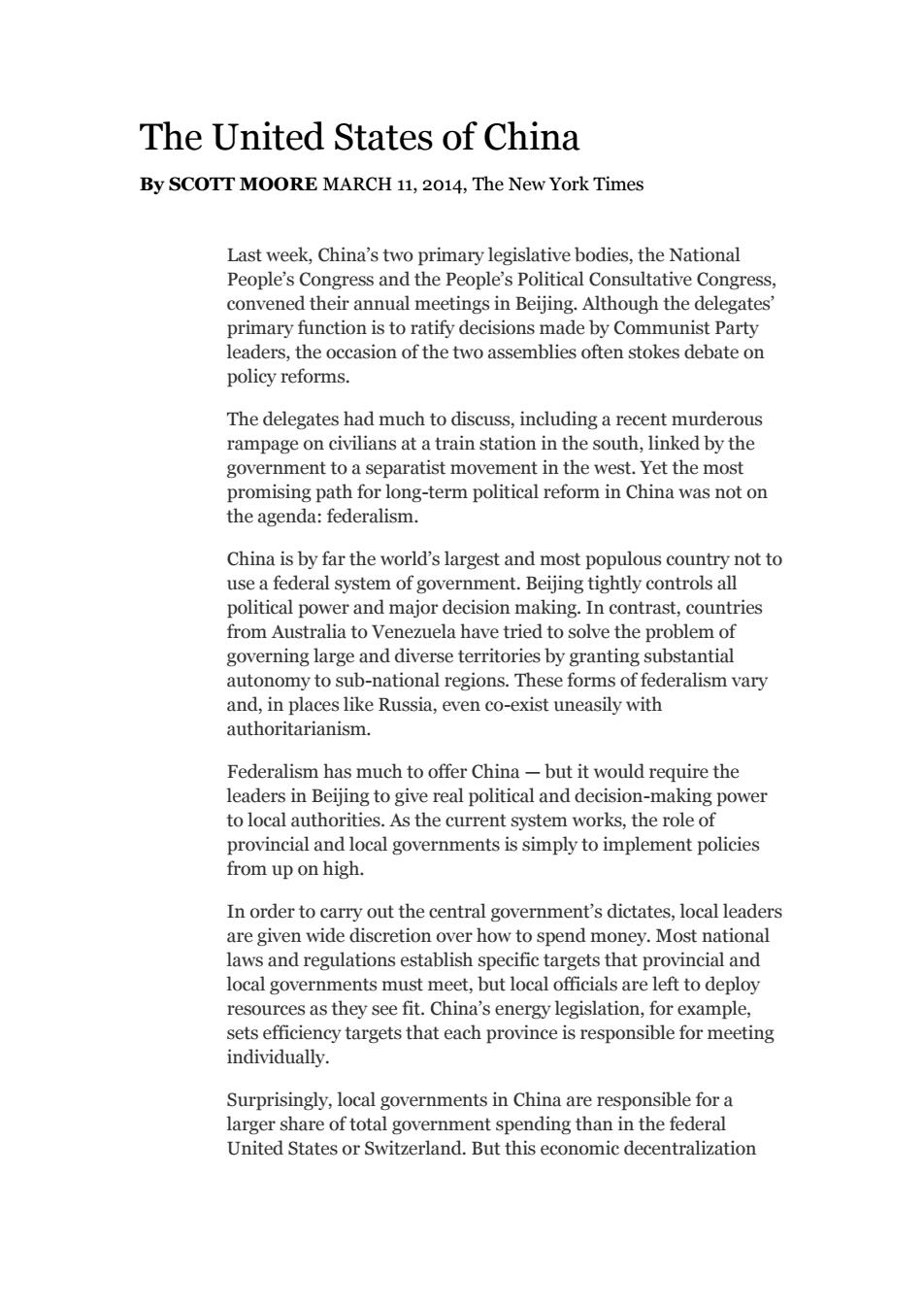正在加载图片...

The United States of China By SCOTT MOORE MARCH 11,2014,The New York Times Last week,China's two primary legislative bodies,the National People's Congress and the People's Political Consultative Congress, convened their annual meetings in Beijing.Although the delegates primary function is to ratify decisions made by Communist Party leaders,the occasion of the two assemblies often stokes debate on policy reforms. The delegates had much to discuss,including a recent murderous rampage on civilians at a train station in the south,linked by the government to a separatist movement in the west.Yet the most promising path for long-term political reform in China was not on the agenda:federalism. China is by far the world's largest and most populous country not to use a federal system of government.Beijing tightly controls all political power and major decision making.In contrast,countries from Australia to Venezuela have tried to solve the problem of governing large and diverse territories by granting substantial autonomy to sub-national regions.These forms of federalism vary and,in places like Russia,even co-exist uneasily with authoritarianism. Federalism has much to offer China-but it would require the leaders in Beijing to give real political and decision-making power to local authorities.As the current system works,the role of provincial and local governments is simply to implement policies from up on high. In order to carry out the central government's dictates,local leaders are given wide discretion over how to spend money.Most national laws and regulations establish specific targets that provincial and local governments must meet,but local officials are left to deploy resources as they see fit.China's energy legislation,for example, sets efficiency targets that each province is responsible for meeting individually. Surprisingly,local governments in China are responsible for a larger share of total government spending than in the federal United States or Switzerland.But this economic decentralizationThe United States of China By SCOTT MOORE MARCH 11, 2014, The New York Times Last week, China’s two primary legislative bodies, the National People’s Congress and the People’s Political Consultative Congress, convened their annual meetings in Beijing. Although the delegates’ primary function is to ratify decisions made by Communist Party leaders, the occasion of the two assemblies often stokes debate on policy reforms. The delegates had much to discuss, including a recent murderous rampage on civilians at a train station in the south, linked by the government to a separatist movement in the west. Yet the most promising path for long-term political reform in China was not on the agenda: federalism. China is by far the world’s largest and most populous country not to use a federal system of government. Beijing tightly controls all political power and major decision making. In contrast, countries from Australia to Venezuela have tried to solve the problem of governing large and diverse territories by granting substantial autonomy to sub-national regions. These forms of federalism vary and, in places like Russia, even co-exist uneasily with authoritarianism. Federalism has much to offer China — but it would require the leaders in Beijing to give real political and decision-making power to local authorities. As the current system works, the role of provincial and local governments is simply to implement policies from up on high. In order to carry out the central government’s dictates, local leaders are given wide discretion over how to spend money. Most national laws and regulations establish specific targets that provincial and local governments must meet, but local officials are left to deploy resources as they see fit. China’s energy legislation, for example, sets efficiency targets that each province is responsible for meeting individually. Surprisingly, local governments in China are responsible for a larger share of total government spending than in the federal United States or Switzerland. But this economic decentralization